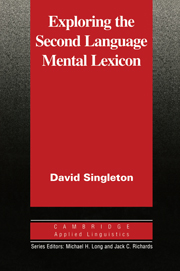Series editors' preface
Published online by Cambridge University Press: 05 October 2012
Summary
Influenced by the dominant preoccupation in theoretical linguistics with phonology, morphology and syntax during the first two decades of its modern existence, SLA research, too, from 1960 to 1980 heavily emphasised morphosyntax, and to a lesser extent phonology. L2 vocabulary, like interlanguage pragmatics, was largely ignored by all but a handful of researchers, few of whom specialised in the lexicon. Things have changed somewhat in the past ten years, perhaps again in part because of the retreat by many linguists from theories which required a plethora of detailed syntactic rules to handle low-level grammatical phenomena in favour of syntactically less powerful ones, and of theories, such as LFG, which handle the same phenomena through lexically based or sensitive rules of various kinds. A similar move can be seen in child language acquisition research over the same period, as exemplified by the work of Pinker, P. Bloom, and others.
The past decade has witnessed a welcome and much needed change, of which Exploring the second language mental lexicon is the most recent example. David Singleton's contribution should serve language educators and applied linguists well in at least three ways. First, his book provides an extensive review of much of the recent first and second language work, in both developmental and experimental psycholinguistics. Second, the book contains the most comprehensive exposition available of the methodology and research findings on L2 vocabulary development from the longitudinal study Singleton and others conducted under the auspices of the Trinity College Dublin Modern Languages Research Project.
- Type
- Chapter
- Information
- Exploring the Second Language Mental Lexicon , pp. xi - xiiPublisher: Cambridge University PressPrint publication year: 1999

